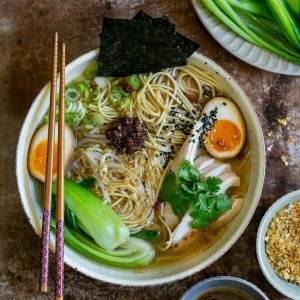
Homemade Chicken Ramen Noodle Soup
A hearty bowl of spicy ramen soup, garnished with poached chicken, fresh noodles, crunchy vegetables and soy sauce pickled eggs. A recipe not only for winter but one that's so easy to follow, you will want to make it throughout the year!
Equipment
- stock pot
- small pot
- strainer
- soup ladle
Ingredients
for the pickled eggs
- 6 eggs
- 110 millilitre water
- 110 millilitre soy sauce
- 3 tablespoon mirin
for the ramen soup
- 1 whole organic chicken (2.2kg/4.8lb)
- 5 litre water
- 1 white onion
- 1 leek (dark green top removed)
- 2 garlic cloves
- 1 thumb ginger
- 3 tablespoon white miso paste
- 2 tablespoon mirin
- 2 tablespoon soy sauce
- 1 tablespoon sesame oil
- salt to taste
for the toppings
- 6 small pok choy
- 500 gram fresh ramen noodles (28og/10oz dried noodles)
- 3 spring onions
- 250 gram bean sprouts
- 4 nori sheets
- 50 gram crispy fried garlic
- 100 gram crispy chili oil
- ⅓ bunch coriander picked
- 30 gram toasted sesame seeds
Instructions
for the pickled eggs
- Cook the eggs in boiling water for 6 minutes. Cool down completely in cold water and peel. Mix water with the soy sauce and mirin and add the eggs. Marinate the eggs submerged in the liquid for at least 6 hours, preferably 12 hours.
for the ramen soup
- In a large stock pot add water and submerge the whole chicken. Place on high heat and bring to a boil.
- Meanwhile prep the burnt onion. Cut the onion in half and place the cut side down in a pan on high heat. No oil is required to burn the onion.
- When the stock has boiled, reduce to low heat and skim the white foam floating on the surface with a ladle.
- Add the burnt onion, leek, garlic, ginger, miso paste, mirin, soy sauce, sesame oil and season lightly with salt.
- Now bring the stock back onto high heat. Once the stock has boiled, reduce to a simmer. After the stock has cooked for 45 minutes remove the pot from the heat and leave it to cool.
- After 5 minutes remove the chicken and let it cool. Once the chicken has cooled enough to handle, remove the legs and breasts from the carcass and portion them up for the ramen soup.
- Taste the soup and adjust seasoning if needed. Strain through a sieve and keep warm.
for the toppings
- While the stock is cooking, prepare your toppings. Cut the pok choy in half and blanche in salted water for about 1 minute. Refresh under cold running water.
- Blanche the bean sprouts the same way for about 30 seconds.
- Cut the spring onions into fine slices and cut the nori sheets in squares. Cut the soy eggs in half.
- Once the ramen soup and other ingredients are ready, Cook the ramen noodles, as per packet instructions.
to plate up
- Reheat the vegetables in a pot of water. Arrange the noodles, chicken and vegetables in a large bowl and pour the hot ramen soup on top. Garnish with all the prepared toppings and serve with chop sticks and soup spoons.
Notes
I am aware that the broth is the most important part of ramen and should not be achieved by taking short cuts. However I promised a recipe that can be done in an hour hence I leave it to you to reduce the broth or not before serving.
Taste the broth after you have removed the chicken. If it is too weak to your taste, reduce the broth until you are happy with the flavour. If not required, add enough seasoning to inject more flavour. Overall you want to keep it rather neutral as you will add the tare to your ramen.
Nutrition
Nutrition Facts
Homemade Chicken Ramen Noodle Soup
Amount Per Serving (180 g)
Calories 642
Calories from Fat 198
% Daily Value*
Fat 22g34%
Cholesterol 164mg55%
Sodium 4099mg178%
Carbohydrates 88g29%
Fiber 12g50%
Sugar 19g21%
Protein 32g64%
Vitamin A 38219IU764%
Vitamin C 389mg472%
Calcium 967mg97%
Iron 13mg72%
* Percent Daily Values are based on a 2000 calorie diet.
Tried this recipe?Tag @between2kitchens or hashtag #between2kitchens